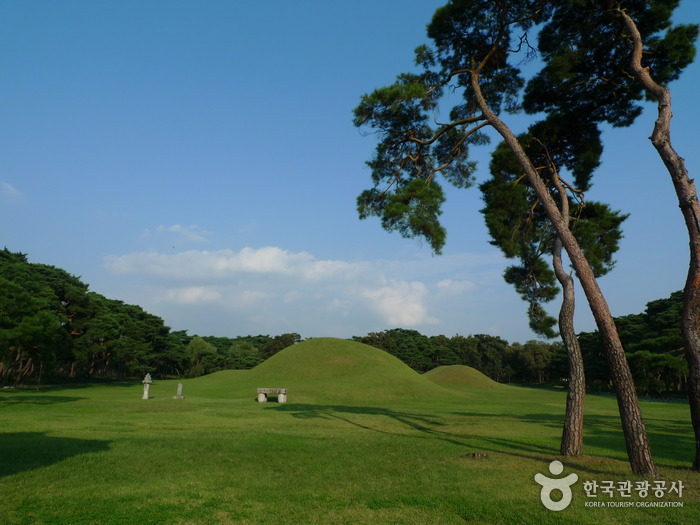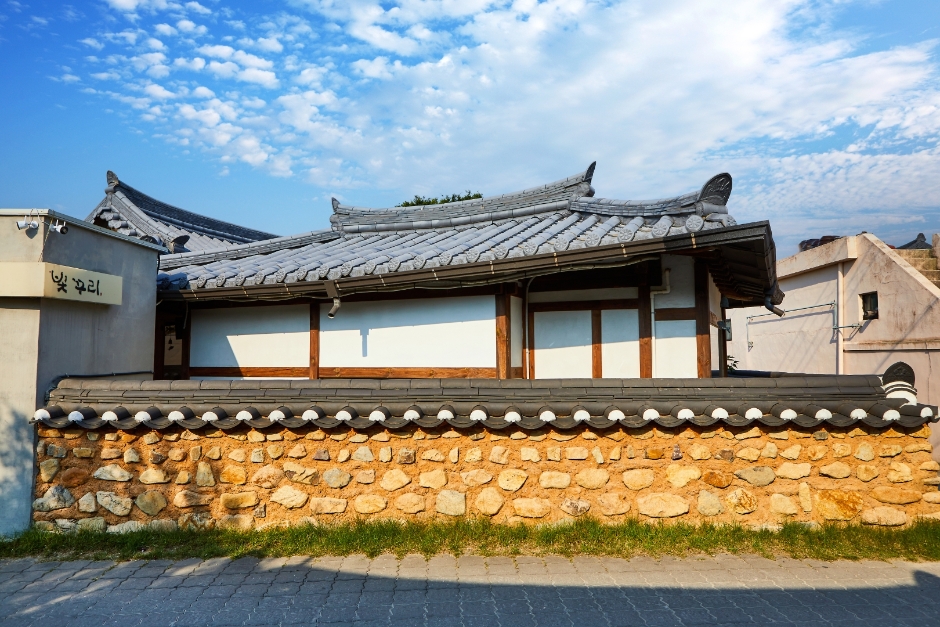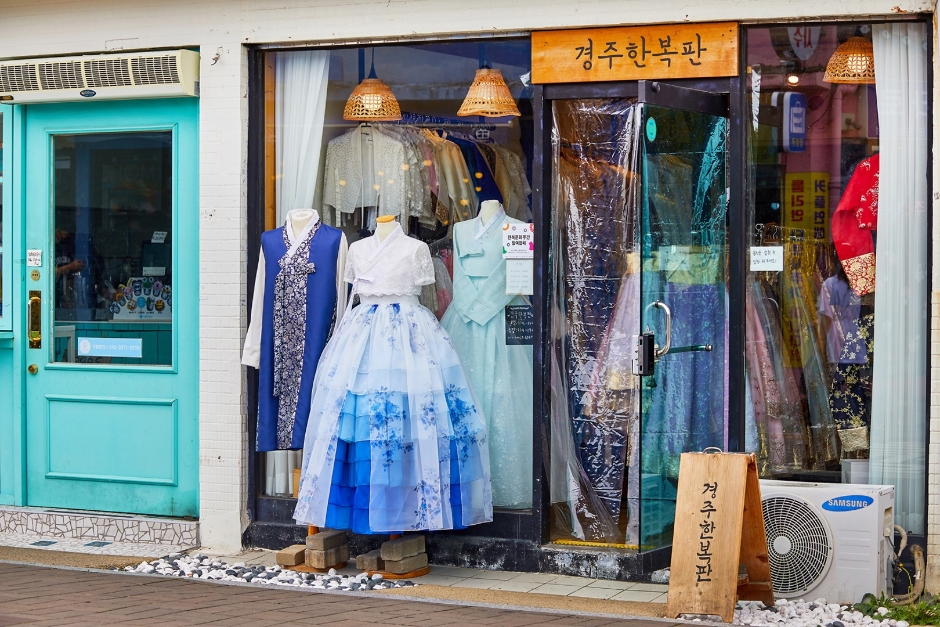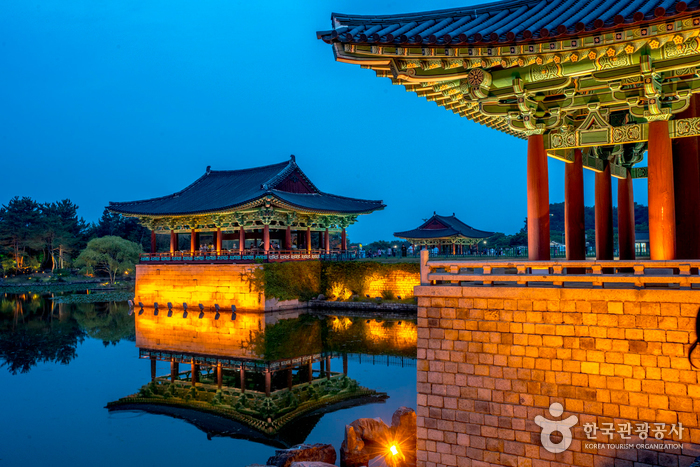Hanok Stay Sohwa [Korea Quality]한옥스테이 소화[한국관광 품질인증]
1.0Km 2024-08-14
5 , Gukdang 2-gil, Gyeongju-si, Gyeongsangbuk-do
+82-507-1325-7205
Hanok Stay Sohwa near the famous Hwangnidan-gil in Gyeongju, Gyeongsangbuk-do, is a modern hanok that opened its doors in 2022, and combines tradition with sophistication. Accommodation consists of a living room, two sleeping rooms (bedroom and ondol), two bathrooms and a kitchen, plus an outdoor terrace and a heated mini swimming pool. Visitors will find rest and comfort here, however busy and stressed they were when they set out. The hanok stay only accepts bookings from one group per day.
The Divine Bell of King Seongdeok (성덕대왕신종)
1.0Km 2020-04-04
186, Iljeong-ro, Gyeongju-si, Gyeongsangbuk-do
+82-54-740-7500
The Divine Bell of King Seongdeok, the largest Korean bell preserved, stands 3.75-meter tall, has a lip diameter of 2.27 meters, and is 11 to 25 entimeters wide. In 1997, Gyeongju National Museum weighed it at 18.9 tons. The bell was cast to pay tribute to the memory of King Seongdeok. It was completed in 771 and named ‘The Divine Bell of King Seongdeok.’ However, because the bell was installed at Bongdeoksa Temple, it has also been called the Bell of Bongdeoksa.
The bell is also known as the Emile Bell, a name derived from an ancient legend in which a child was sacrificed in order to give sound to the bell, whose echoes of ‘em-ee-leh’ resemble the traditional Korean word for "mommy."
The tubular sound pipe at the top of the bell that helps the sound reverberate is a unique feature that can be found only in Korean bells. The yongnyu, which serves as a loop to hang the bell, has been decorated to resemble a dragon’s head. A band of arabesque patterns can be found at the shoulder, and the striking point of the bell is in the shape of a lotus flower.
The magnificent design and inscription methods used in this bell exemplify the artisan's craftmanship of the Unified Silla period. The bell is also inscribed with over one thousand Chinese characters, and its beauty and integrity have been meticulously preserved despite the passage of over 1,300 years.
Sihyu Byeoldang [Korea Quality] 시휴별당[한국관광 품질인증]
1.0Km 2023-05-23
15-1, Cheomseong-ro 49beon-gil, Gyeongju-si, Gyeongsangbuk-do
+82-504-0904-2575
Sihyu Byeoldang is a hanok stay near the famous Hwangnidan-gil in Gyeongju, Gyeongsangbuk-do, whose name is made up of hanja characters meaning "time," "separation," "rest," and "home." There are three types of room, spread across a sarangchae, an anchae and an annex. The sarangchae and annex have access to an outdoor swimming pool, while the anchae has an indoor bathtub. We hope the house’s warm atmosphere and the beautiful surrounding scenery will help guests feel truly rested and at home - and perhaps even that time has briefly paused.
Gyeongju Five Royal Tombs (경주 오릉)
1.1Km 2022-12-27
38-9, Geumseong-ro, Gyeongju-si, Gyeongsangbuk-do
+82-54-750-8614
The Five Royal Tombs (called Oreung in Korean) have been officially designated Historic Site No. 172 and are the final resting places of four kings of the Park clan—King Park Hyeokgeose (founder of the Silla Kingdom), King Namhae, King Yuri, and King Jabi—and one queen (Queen Aryeong, wife of King Park Hyeokgeose).
To the east of the royal tombs lies Sungdeokjeon Shrine, which holds the ancestral tablet of King Park Hyeokgeose. Behind the shrine is the Aryeongjeong Well, said to be the birthplace of Queen Aryeong.
Bitgguri (빛꾸리)
1.1Km 2023-07-12
16-1 , Sonhyoja-gil, Gyeongju-si, Gyeongsangbuk-do
+82-54-777-4421
This cafe is located in a small alley near Cheonmachong Tomb (Daereungwon Ancient Tombs), in a renovated old hanok and yard. This place's seating is on the floor, so the traditional atmosphere comes alive. Bitgguri’s signature menu items are grilled saekdong injeolmi (bean-powder-coated rice cake) and tangerine ginger tea. Dig into the colorful rice cakes, grilled and coated with powdered soybeans, and traditional tea to fully enjoy the classic charms of Gyeongju. The rice cake is enjoyed together with a malt syrup called jocheong, a traditional substitute for honey. Tangerine ginger tea is a traditional tea made with tangerine and ginger. It is quite effective for colds and is full of natural vitamins, so one can feel healthy just by drinking the beverage. The café has a garden decorated with traditional earthenware pots and stone fences topped with tiles, allowing one to enjoy a charming view along with the dessserts. The cafe also hosts one-day classes, such as bojagi (square clothes made to be wrapped around items for transportation) making.
Nadul Hanok [Korea Quality] / 나들한옥 [한국관광 품질인증]
1.1Km 2020-09-09
4-1, Jjoksaem-gil, Gyeongju-si, Gyeongsangbuk-do
+82-54-777-7738
Nadeul Hanok was opened in 2018 with brand-new facilities, in a location just a minute’s walk from Cheomseongdae Observatory in Gyeongju. You can feel a sense of healing in nature in the traditional style house, built in environment-friendly construction method with wood and earth. The ‘ㄷ’-shaped building creates a snug atmosphere and the hipped-and-gable roof and the curves of the roof tile show the traditional quiet and still flavor of a traditional Korean house. There are 7 rooms in Nadeul Hanok. Among them, the Garam, Gayeon, and Nuri Rooms are offered at 50,000 won for 2 persons during off-season so that visitors can enjoy staying in a traditional Korean house at more affordable prices. All rooms are equipped with a bathroom for better convenience and there is an individual thermostat all year round. Complimentary breakfast made of healthy convenience food is offered to all guests. The menu is composed of barley bread, fruit, coffee, juice, boiled egg, and biscuit, and is subject to change according to situation. What is good is that the breakfast can be delivered to the room if the delivery time is requested during breakfast time, which is from 8 to 9 AM.
It is possible to look around the tourist attractions near Nadeul Hanok on foot. In addition, there are CVs, fast food shops, bike rental shops, and hanbok rental shops adjacent to Nadeul Hanok, enabling a more convenient and joyful tour.
Gyeongju Hwangnidan Street (경주 황리단길)
1.1Km 2024-10-30
1080 Poseok-ro, Gyeongju-si, Gyeongsangbuk-do
Hwangnidan Street was originally known as “Hwangnam Keungil” near Poseok-ro, Hwangnam-dong. Its name comes from the combination of Hwangnam-dong and Gyeongnidan Street in Itaewon, Seoul, meaning the “Gyeongnidan Street of Hwangnam-dong.” The street is home to numerous restaurants, cafes, photo studios, and shops housed in traditional hanok buildings, making it popular among the younger generations in Korea. The street also demonstrates newtro aesthetics due to the remaining old and worn buildings built during the 1960s and the '70s. Hwangnidan Street is near Cheomseongdae Observatory, Daereungwon Ancient Tombs, and other major tourist sites, allowing the street to become a popular Gyeongju attraction as well.
Gyeongju Historic Area [UNESCO World Heritage] (경주역사유적지구 [유네스코 세계문화유산])
1.1Km 2022-05-11
757, Taejong-ro, Gyeongju-si, Gyeongsangbuk-do
+82-54-779-6100
The Gyeongju Historic Area, registered as a UNESCO World Cultural Heritage on November 2000, is an area that embodies the time-honored history and culture of Gyeongju, the ancient capital of the Silla Kingdom (57 BC-AD 935).
The Gyeongju Historic Area can be divided into 5 major sections. The first section is the Namsan Area, a treasure trove of Buddhist art masterpieces dating back to the Silla Kingdom. Gyeongju Namsan Mountain (often referred to as an ‘outdoor museum’) is home to many historical heritage sites from the Silla Kingdom. Major attractions include: Poseokjeong (Historic Site No.1), Tapgok Maaejosanggun (Treasure No. 201), Cheollyongsaji Three-story Stone Pagoda (Treasure No. 1188), Chilbulam Maae Stone Buddha (Treasure No. 200), Bulgok Seated Stone Buddha (Treasure No. 198), and 37 other Buddhist relics
The second section is the Wolseong Area, one of the former palace sites of the Silla Kingdom. The area consists of Gyerim (Historic Site No. 19); Donggung Palace and Wolji (Historic Site No. 18), a Silla Royal Palace site; and Cheomseongdae (National Treasure No. 31), the oldest observatory in the East. Daereungwon area, the third area, features a cluster of the royal graves of the Kings and Queens of Silla.
Also in the same area are Gobungun (a cluster of old graves) in Nodong-ri (Historic Site No. 38), Gobungun (a cluster of old graves) in Noseo-ri (Historic Site No. 39) Gobungun (a cluster of old graves) in Hwangnam-ri (Historic Site No. 40), and Oreung (Historic Site No. 172), among others. Archaeologists have discovered a number of invaluable relics and historic items in this area such as Geumgwan (golden crown), Cheonmado (a painting of flying horses), and numerous pottery pieces. These finds are perhaps the greatest clues into the life of the people of the Silla Dynasty.
Area number four, the Hwangnyongsa Area, is where the former site of the Hwangnyongsa Temple (Historic Site No. 246) and Bunhwangsa Stone Pagoda are located. Lastly, is the Sanseong Area, housing remnants of the major defense system for the capital city. The site consists of Myeonghwalsanseong Fortress (Historic Site No. 47) which is estimated to be around 400 years old.
The Gyeongju Historic Area has a total of 52 designated cultural assets that are registered as World Cultural Heritages.
Gyeongju Hanbokpan (경주한복판)
1.1Km 2024-04-08
1077-2 Poseok-ro, Gyeongju-si, Gyeongsangbuk-do
Gyeongju Hanbokpan is a hanbok rental store located in the middle of Hwangnidan Street. Hanbok attires are available in a variety of materials, colors, and seasons. There are many hanbok wears reflecting the latest trends, so they look good on anyone and are easy to wear. Besides changing clothes, the store owner also assists customers with hair accessories. There are many family customers as the store also offers hanbok for both men and children. Customers can also print the photos they took with their smartphone upon retrning the hanbok, making it an even more memorable experience.
Donggung Palace and Wolji Pond (경주 동궁과 월지)
1.2Km 2024-10-31
102 Wonhwa-ro, Gyeongju-si, Gyeongsangbuk-do
+82-54-750-8655
Donggung Palace and Wolji Pond in Gyeongju are secondary palace sites of Silla. The palace, along with other secondary palaces, was used as the eastern palace where the prince lived, and banquets were held during auspicious events or to welcome important guests. It is also where King Gyeongsun of Silla invited King Wang Geon of Goryeo and had a feast to complain about the critical situation in 931 after being invaded by Gyeon Hwon. After unifying the three kingdoms, Silla's King Munmu dug a large pond in the 14th year of his reign (674), creating three islands in the center of the pond along with a 12-peaked mountain to the northeast. Beautiful flowers and trees were planted here, and rare birds and animals were raised. In the Samguksagi (History of the Three Kingdoms) from the Goryeo dynasty, there is only a record of Imhaejeon Hall and no mention of Anapji Pond. After Silla fell and the place fell into ruins during the Goryeo and Joseon dynasties, poets and calligraphers looked at the pond and recited a line of poetry that says, “The once splendid palace is gone, and only geese and ducks fly in.” That's why the place is called Anapji, using the letters 'an' for wild geese and 'ab' for ducks. In the 1980s, pottery fragments with the inscription "Wolji" were excavated, and it was confirmed that this area was originally called "Wolji," which means "a pond that reflects the moon." And the name Anapji was changed to Wolji Pond afterwards.
![Hanok Stay Sohwa [Korea Quality]한옥스테이 소화[한국관광 품질인증]](http://tong.visitkorea.or.kr/cms/resource/72/2948972_image2_1.jpg)



![Nadul Hanok [Korea Quality] / 나들한옥 [한국관광 품질인증]](http://tong.visitkorea.or.kr/cms/resource/86/2636486_image2_1.jpg)
![Gyeongju Historic Area [UNESCO World Heritage] (경주역사유적지구 [유네스코 세계문화유산])](http://tong.visitkorea.or.kr/cms/resource/03/2656603_image2_1.jpg)


 English
English
 한국어
한국어 日本語
日本語 中文(简体)
中文(简体) Deutsch
Deutsch Français
Français Español
Español Русский
Русский